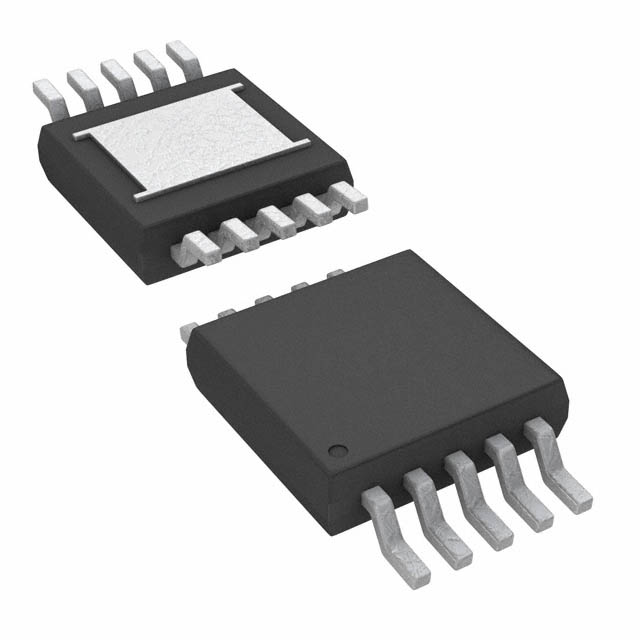Xem thông số kỹ thuật để biết chi tiết sản phẩm.

LTC1407CMSE#PBF
Product Overview
Category
LTC1407CMSE#PBF belongs to the category of analog-to-digital converters (ADCs).
Use
This product is primarily used for converting analog signals into digital data, making it suitable for various applications in industries such as telecommunications, industrial automation, and medical equipment.
Characteristics
- High-resolution: The LTC1407CMSE#PBF offers a resolution of 14 bits, ensuring accurate conversion of analog signals.
- Low power consumption: This ADC operates at low power levels, making it energy-efficient.
- Fast conversion rate: With a maximum sampling rate of 1.25 MSPS (Mega Samples Per Second), it can quickly convert analog signals into digital data.
- Wide input voltage range: The LTC1407CMSE#PBF supports an input voltage range of ±10V, allowing it to handle a wide variety of signal amplitudes.
Package
The LTC1407CMSE#PBF comes in a small MSOP-10 package, which provides compactness and ease of integration into electronic systems.
Essence
The essence of LTC1407CMSE#PBF lies in its ability to accurately convert analog signals into digital data, enabling further processing and analysis by digital systems.
Packaging/Quantity
This product is typically packaged in reels or tubes, with each reel containing 250 units.
Specifications
- Resolution: 14 bits
- Sampling Rate: Up to 1.25 MSPS
- Input Voltage Range: ±10V
- Power Supply: 2.7V to 5.5V
- Operating Temperature Range: -40°C to 85°C
Detailed Pin Configuration
The LTC1407CMSE#PBF has the following pin configuration:
- VREF-
- VREF+
- VIN
- GND
- SCK
- SDI
- CS
- SDO
- DGND
- VCC
Functional Features
- High-resolution conversion: The LTC1407CMSE#PBF provides accurate 14-bit analog-to-digital conversion, ensuring precise representation of input signals.
- Serial interface: It features a serial interface for easy integration with microcontrollers and digital systems.
- Low power consumption: This ADC operates at low power levels, making it suitable for battery-powered applications.
- Flexible input range: With a wide input voltage range of ±10V, it can handle various signal amplitudes.
Advantages and Disadvantages
Advantages
- High resolution ensures accurate conversion.
- Low power consumption extends battery life.
- Compact package allows for easy integration.
- Wide input voltage range accommodates diverse signal amplitudes.
Disadvantages
- Limited to 14-bit resolution, which may not be sufficient for certain high-precision applications.
- Requires an external reference voltage source.
Working Principles
The LTC1407CMSE#PBF utilizes a successive approximation register (SAR) architecture to convert analog signals into digital data. It samples the analog input voltage and compares it to a reference voltage using a binary search algorithm. By iteratively adjusting the digital code, it converges on the most accurate representation of the analog input.
Detailed Application Field Plans
The LTC1407CMSE#PBF finds applications in various fields, including:
- Telecommunications: Used in communication systems for converting analog voice signals into digital format for processing and transmission.
- Industrial Automation: Enables precise measurement and control of analog signals in industrial automation systems.
- Medical Equipment: Utilized in medical devices for capturing and analyzing physiological signals such as ECG (electrocardiogram) or EEG (electroencephalogram).
Detailed and Complete Alternative Models
- LTC1406CMSE#PBF: Similar to LTC1407CMSE#PBF but with a lower resolution of 12 bits.
- LTC1408CMSE#PBF: Offers higher resolution of 16 bits for applications requiring greater precision.
- LTC1409CMSE#PBF: Provides a higher sampling rate of 2.5 MSPS for faster conversion.
These alternative models offer different specifications to cater to specific application requirements.
Word count: 525 words
Liệt kê 10 câu hỏi và câu trả lời thường gặp liên quan đến ứng dụng LTC1407CMSE#PBF trong giải pháp kỹ thuật
Sure! Here are 10 common questions and answers related to the application of LTC1407CMSE#PBF in technical solutions:
Q: What is LTC1407CMSE#PBF? A: LTC1407CMSE#PBF is a specific model of an analog-to-digital converter (ADC) manufactured by Linear Technology (now part of Analog Devices). It is designed for high-precision data acquisition applications.
Q: What is the resolution of LTC1407CMSE#PBF? A: LTC1407CMSE#PBF has a resolution of 14 bits, which means it can represent analog signals with 2^14 (16,384) different digital values.
Q: What is the sampling rate of LTC1407CMSE#PBF? A: The sampling rate of LTC1407CMSE#PBF is determined by the external clock frequency provided to the device. It can support sampling rates up to 1.5 million samples per second (MSPS).
Q: What is the input voltage range of LTC1407CMSE#PBF? A: The input voltage range of LTC1407CMSE#PBF is typically ±VREF, where VREF is the reference voltage supplied to the ADC. It can be configured to accept single-ended or differential input signals.
Q: How does LTC1407CMSE#PBF communicate with a microcontroller or processor? A: LTC1407CMSE#PBF uses a serial interface called SPI (Serial Peripheral Interface) to communicate with microcontrollers or processors. It requires four signal lines: SCLK (serial clock), SDI (serial data input), SDO (serial data output), and CS (chip select).
Q: Can LTC1407CMSE#PBF operate with a single power supply? A: Yes, LTC1407CMSE#PBF can be powered by a single positive power supply voltage (VDD) ranging from 2.7V to 5.25V.
Q: What is the typical power consumption of LTC1407CMSE#PBF? A: The typical power consumption of LTC1407CMSE#PBF depends on the sampling rate and other factors. It ranges from a few milliwatts to a few hundred milliwatts.
Q: Does LTC1407CMSE#PBF have built-in digital filters? A: No, LTC1407CMSE#PBF does not have built-in digital filters. However, it provides a digital output that can be processed using software-based filters or external hardware filters.
Q: Can LTC1407CMSE#PBF be used in battery-powered applications? A: Yes, LTC1407CMSE#PBF can be used in battery-powered applications due to its low power consumption and wide operating voltage range.
Q: Are there any evaluation boards or development kits available for LTC1407CMSE#PBF? A: Yes, Analog Devices offers evaluation boards and development kits specifically designed for LTC1407CMSE#PBF, which can help in prototyping and testing the ADC in various applications.
Please note that the answers provided here are general and may vary depending on specific application requirements and datasheet specifications.

